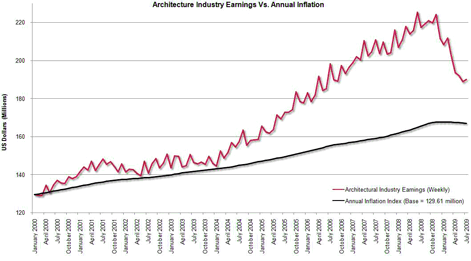Coping with the Downturn, Firms Focus on Value
Cost control, income enhancement remain the lynchpins of profitability
by Matthew Lynch
Summary: The deterioration of the construction sector has dealt a sobering blow to the architecture industry. Individuals, businesses, and public agencies are simply no longer prepared nor sufficiently equipped to spend capital on construction. This lack of demand has subjected the industry to substantial devaluation. The total number of projects available to architects has decreased dramatically, shown by a freefall in billings over the last 19 months on the AIA’s Architectural Billings Index. “Of the few remaining contracts being signed,” says AIA Chief Economist Kermit Baker, PhD, Hon. AIA, “fewer projects are new construction and a greater percentage is smaller in scale and simpler in scope.” The aggregate effect is an industry that is surviving on fewer, smaller, simpler projects.
In an effort to find equilibrium between supply and demand, architects have slashed labor costs. “With new work scarce,” explains Scott Simpson, FAIA, senior director at KlingStubbins, “firms have been under increasing pressure [and] have cut costs and reduced overhead to improve the bottom line.” Since June 2008, the industry has lost some 35,200 employees and decreased the workweek by a massive 2.3 hours per employee. The industry as a whole is now working 1.7 million fewer hours per week than last year.

Christine Brack, a principal consultant with ZweigWhite, has observed that more complex projects demand more varied expertise, and therefore represent more opportunity for specialized, value-adding services. “Adding services and expertise to the scope of work can substantiate higher fees for the architect,” she explains. For example, an architect can add significant value to a project by offering LEED certification, construction management, IPD, or a post-contract evaluation. “Know your competitive advantage,” says Brack, “and demonstrate the worth of your services.”
Simpson adds that architects need to start concentrating less on reducing supply and more on engendering demand. “Too many clients look at design services as cost,” says Simpson. To stimulate demand, architects need to articulate clearly the value proposition of an architectural investment—low risk, high return. “We should be showing them how good design creates real, measurable value. To become trusted advisors, architects need to be part of the value proposition.”
In a scenario where demand for architecture services is low, a reduced number of clients with the capacity and willingness to invest in architecture is likely to be increasingly discerning and averse to risk. “Controlling scope, cost, and schedule is important to them,” Simpson explains. “This reduces risk and raises the value of design in their eyes.”
Copyright © 2009 Matthew Lynch. Used with permission. |


